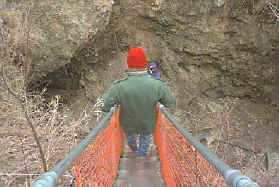 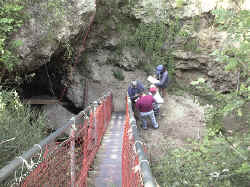
A LADDER WAS INSTALLED TO ACCESS THE
EXCAVATION
PICTURE CREDIT--KEITH HENDRICKS
This
picture shows the ladder that accesses the site and descends to approximately 32 feet.
The lowest part of the sink hole measures 50 feet deep.
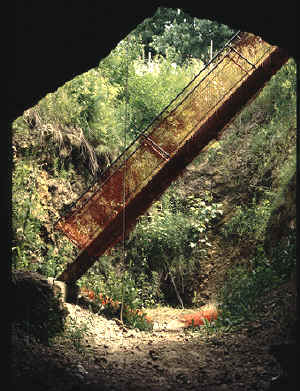
LOOKING OUT FROM INSIDE THE CAVE
SHERIDEN CAVE SITE
PICTURE CREDIT--KEN
TANKERSLEY
This
picture was taken from inside Sheriden Cave looking out into the sink hole
area. The sink hole measures more than 65 feet across and 50 feet deep. A
direct passage from Sheriden Cave to Indian Trail Caverns has not yet been
made but it's believed the two are the same cave system.
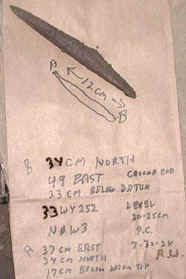
BONE SPEAR POINT & NOTES JUST
AFTER DISCOVERY
SHERIDEN CAVE SITE
PICTURE CREDIT KEITH
HENDRICKS--HENDRICKS COLLECTION
Sheriden Cave was first excavated by paleontologist H. Gregory McDonald
from the Cincinnati Museum of Natural History after the bones of extinct
Ice Age animals were discovered during the original earth removal process.
Dr. MacDonald worked there excavating animal bones from the summer of 1990
to the summer of 1995. When a student from Michigan State University,
Kenneth Ford, discovered one of the two rare Ice Age bone spear points so
far recovered on this site. This discovery left no doubt that they were
now excavating in an ancient Paleo-Indian habitation site and if the
excavation was to proceed farther it should be done by archaeologist
rather than paleontologist.
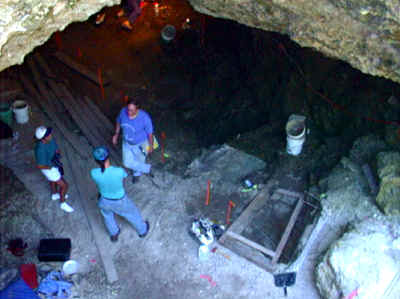
CLICK ON PICTURE FOR LARGE IMAGE
LOOKING DOWN INTO SHERIDEN CAVE
PICTURE CREDIT--KEITH
HENDRICKS
In
1996 Dr. Kenneth B. Tankersley from Kent State University became involved
after visiting the site and examining a bone spear point and a stone
scraper from the previous excavation. It was then decided to excavate the
remaining deposits inside the cave. A project that continued for four
years until the summer of 2000. The project was accomplished by volunteers
and students from Kent State University and the Cleveland Museum of
Natural History.

CLICK ON PICTURE FOR LARGE IMAGE
ARCHAEOLOGICAL EXCAVATION INSIDE
SHERIDEN CAVE
PICTURE CREDIT--KEITH
HENDRICKS
This
picture shows some of the archaeological technique used to excavate the
many bones and limited number of artifacts. The area is divided with
string into meter squares so all the items recovered can be recorded in
the vertical and horizontal planes. Some of the standard tools used by
archaeologist can be seen in this picture such as the flexible steel and
straight rulers, collection bags and digging tools. The line level,
located on the string in the center, is a tool that keeps everything
level.
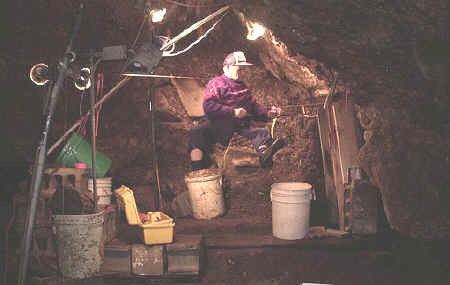
CLICK ON PICTURE FOR LARGE IMAGE
CAVE EXCAVATION IS DIFFERENT
PICTURE CREDIT--KEITH
HENDRICKS
Most excavations occur in the open air and are not dependent on as much
equipment as for example underwater and cave archaeology would use. As
this picture shows, the one obvious item needed for excavating in a cave is
plenty of lighting. Some areas of the excavation can also be very cramped
for space.
|



